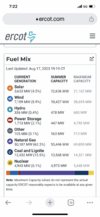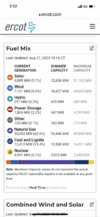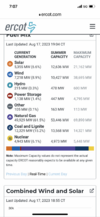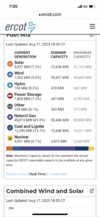@mspohr , no where in that article was that stated, making *sugar* up again! Uri was not even closely similar. sad fact, was we were sill liquifying natural gas for export during the storm... plain and simple the NG system let us down, with the failures and very high demand (heating, electric plants and export).
Updated: Sep. 8, 2022 5:53 p.m.
Jason Fochtman, Houston Chronicle / Staff photographer
As Californians brace for another afternoon of triple-digit temperatures, the state's grid operator has asked residents to conserve power for the ninth-straight day.
That California's grid is on the brink of emergency conditions during a heat wave has sparked a flurry of conversations on Twitter, with folks both criticizing and praising the state's response. Others have compared the response and situation to Texas' recent electricity woes.
Famed newscaster Dan Rather (
idiot), a native Texan, noted: "There was an unusual weather event in California and Governor Newsom asked residents to pitch in during a moment of crisis. People responded for the good of the community. The crisis passed with the electricity still on. Is a better model what we experienced in Texas?"
But while the situation facing California differs in many ways to what Texas dealt with during the February 2021 freeze, some issues faced by both the California Independent System Operator and the Electric Reliability Council of Texas are remarkably similar. Here's a look at the differences and similarities of the two states' power landscapes.
1.) Abnormal heat waves don't stress the grid in the same ways abnormal freezes do.
In the Texas freeze and the West's current heat wave, demand for power spiked. Peak demand in California could rise above 51,300 megawatts, which would be a record. ERCOT shattered its own demand record at least 11 times this summer, reaching 80,000 megawatts for a few minutes in late July. One megawatt is enough to power about 200 homes on a hot Texas summer day.
(Despite having more than 10 million more people, demand in California is much less than it is in Texas, thanks to their typically temperate weather and relative lack of heavy industry, experts say.)
During the freeze, demand for power in Texas also spiked well above the winter average, with some experts saying it could have reached 77,000 megawatts if not for ERCOT telling utilities to cut power. Before that order, ERCOT also told Texans to conserve power, similar to how California is asking residents to do the same now.
CHRIS TOMLINSON: Texas electric grid recommendations are just more crony capitalism costing consumers
But there is a huge difference -- the amount of power generation available.
At the peak of the winter storm, more than half of ERCOT's winter generation capacity was knocked offline due to frozen natural gas pipelines, equipment failures among renewables and infrastructure not built to withstand nearly a week of below freezing temperatures. Generators of all types struggled.
California, by comparison, is not facing any widespread outages among power generators. Natural gas generation has remained stable amid cooler, overnight hours, and solar production is shaping up to provide more than 10,000 megawatts this afternoon. The state's problem, now, is sky-high demand.
2.) California's connection to other grids isn't helping much right now. It may not have helped Texas much, either, during the freeze.
While California was
importing more than 8,000 megawatts by around 1 p.m. Houston time, Ed Hirs, an energy fellow at the University of Houston, said the state's neighbors may not be willing to share much of their power as the day wears on. In the past, the state has relied on Oregon, Nevada and Arizona to share their excess power when supplies were tight, he said.
"But now California has figured out, 'Oh hell, when a heat wave hits us, it hits everyone around us, too. We can’t rely on extra power from these states because those consumers don’t want to turn off their power to give it to us," Hirs said.
NEW RULES: Railroad Commission votes to require weatherization for some gas producers
David Tuttle, a research associate with the Energy Institute at University of Texas at Austin, agreed.
"When people are saying we need to interconnect more, if you look at analysis of (the February 2021 freeze), it as a storm didn’t respect the boundaries of Texas," Tuttle said. "It wasn’t like Oklahoma and Louisiana had spare capacity they could export to us while we were freezing. This is not the first time California has had a heat wave and neighboring states were hot also."
3.) Both states are trying to balance large renewable energy portfolios with reliability concerns. That means they'll need more transmission lines and dispatchable generation.
Hirs and Tuttle said California and Texas are in desperate need of so-called dispatchable generation, which can be turned on under certain grid conditions, like some gas turbines and utility scale batteries.
In California, the reliance on solar energy has created a gap between demand and supply in the evening hours, when the sun begins to set but demand remains. The shift toward solar and renewables there has largely been the result of political moves.
A shift toward renewables in Texas, Tuttle said, has been almost entirely market-driven.
"When industrial customers move from California to Texas, they want to be able to say they get their energy from zero-emissions sources," Tuttle said.
But both states must have more dispatchable resources on the grid to make up for times when the renewable resources aren't producing enough to meet demand, Hirs and Tuttle said, and they need enough transmission to get power from renewable resources -- often in rural areas -- to the urban centers where the power is needed.
"Both markets are the same to a certain extent. They both have not given coal, natural gas and nuclear power plants the incentives to stay on the grid," Hirs said. "Both states, as a matter of public policy, did not think backup generation was necessary. Otherwise they would have paid to keep it on the grid"
[email protected]











